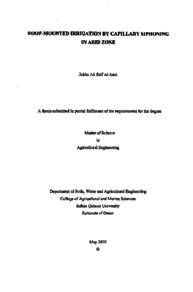Document
Roof-mounted irrigation by capillary siphoning in arid zone
Publisher
Sultan Qaboos University
Gregorian
2010
Language
English
Subject
English abstract
Green roofs (GR) are roof-hoisted structure to make the roof partially or completely covered with vegetation. This study was done to test the feasibility and the technical applicability of GR with a novel capillary siphoning irrigation system in Oman, to investigate whether the designed siphon-pot coolers are economically efficient at the existing electricity and water prices in Oman and to report on laboratory tests with siphoned GR modules as hydrological flood buffers. In this study, a mathematical model, was used to describe the capillary siphoning by some of the capillary rise equations. The green roof experiments with roof-mounted siphons were conducted in January 2009 - June 2009 on the roof of the College of Agricultural and Marine Sciences (CAMS) building at Sultan Qaboos University (SQU). The pots were placed in that open area. Water was diverted to the pots from plastic containers through siphons made of used T-shirts which were rolled and filled with soil. Siphoning flow rate, moisture content in the pots, hydrological parameters and the development of the plants were measured and monitored. The results showed that siphons are feasible and technically suitable for irrigation on Omani roofs. Also, the results indicated that siphons convey water to the pots continuously at of 0.35 to 0.65 L per day per siphon per day. GR proved to have high thermal insulation efficiency. This is because the soil pots reduce the heat fluxes and improve the cooling conditions under their base. Under existing water and electricity prices the suggested GR irrigation-cooling system is economically viable. The least heat-resistant plants (e.g., tomato) planted in January developed well and perished in May. Most heat-tolerant plants (e.g., petunia) şurvived until the end of the experiments. The pot soil profile exhibited good buffer capacity to intercept and retain typical rain and it could utilized in urban water management measures for flood mitigation. The Washburn equation would be appropriate for the interpretation of capillary penetration rates for most systems of practical interest. The Szekely equation is applicable at any stage but gives realistic predictions at very early stages of penetration. If the pore structure characteristics of porous media are not taken into account the applicability of the Washburn or Szekely theories is limited. Temperature has a certain influence on the water, soil and siphons properties. This influence can be examined through the dependence of each particular parameter (e.g. viscosity, contact angle, density, etc) on temperature however to understand the combined effect further studies are necessary
Description
Thesis
Member of
Resource URL
Arabic abstract
من منطلق فكرة زراعة سطح المنازل، والتي تحمل في طياتها عبق وعود صادقة بالمساهمة في الحد من مؤثرات المناخ القاسية، والتي باتت نصب أعين المناهضين لثورة الحفاظ على البيئة، فراودتنا فكرة ري النباتات المزروعة على السطوح بالخاصية الشعرية، و بإستخدام أبسط المواد والخامات المتوافرة في البيئة في يناير ۲۰۰۹ بدأت خطوات المشروع بإختيار الموقع وهو سطح كلية الزراعة والعلوم الزراعية بجامعة السلطان قابوس، وتم إختياره لإرتفاع درجة الحرارة بناء على إرتفاعه المشهود عن الأرض، والتي تمثل أقسی الظروف المناخية المنشود توافرها للتجربة، و أختيرت النباتات بحيث كانت تعود لمختلف العائلات النباتية والنباتات: طماطم، بيتونيا و صباريات، و تمت الزراعة في أصص بإستخدام ثلاث أنواع من الترب : التربة الرملية، تربة الطمي (تربة السد)، وتربة رملية خصبة من مركز البحوث الزراعية بجامعة السلطان قابوس. كانت عملية الري تتم عن طريق توصيل الماء بسيفون متصل بمصدر مياه ثابت. كما تم حساب كمية المياه الواصلة إلى النباتات عن طريق السيفون وتتراوح مابين ۰٫۳۵- ۹۰,. لتر في اليوم. في يونيو ۲۰۰۹ قد وجدت إمكانية زراعة السطوح في سلطنة عمان بإستخدام الخاصية الشعرية حيث وجد صمود أغلبية النباتات حتى نهاية المشروع. كما أن كمية المياه المستخدمة كانت بنسب قليلة. ومما يجدر ذكره وجوب مراعاة إنتقاء النباتات التي تتحمل درجات الحرارة العالية كالصباريات والبيتونيا وتجنب النباتات التي لا تقاوم درجة الحرارة العالية كالطماطم. إن تطبيق فكرة زراعة سطح المنازل بمجال أوسع سيساهم في خفض درجات الحرارة، وعزلها عن المباني، وتقليل استهلاك الطاقة الكهربائية في فصل الصيف كنتيجة حتمية، كما تلعب التربة المستخدمة دورا في تخزين كميات من مياه الأمطار في حالة غزارة هطولها مما يساهم في التقليل من الفيضانات و زيادة مدة تحرك المياه في التربة إلى أن تصل إلى مياه التصريف. ولاننسي المظهر الجمالي الذي يرجع له الفضل في تحسين الحالة النفسية للأفراد وبالتالي زيادة فاعليتهم في المجتمع.
Category
Theses and Dissertations

